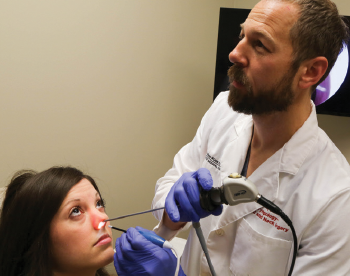
A physician at Ohio State University uses the Vivaer system.
© The Ohio State University/Wexner Medical Center
As technologies continue to evolve, so do the options otolaryngologists have for managing the myriad health concerns presented by their patients. Minimally invasive procedures are among the leading new technologies that are making it possible to do in the office setting what was once only done in the operating room.
Explore This Issue
September 2018Here are several novel technologies that are expanding the toolbox from which otolaryngologists draw to treat their patients.
New Procedure for Nasal Airway Obstruction
A new device that uses radiofrequency energy to modify the nasal valve area is showing promise as a novel way to treat symptoms of nasal obstruction. Called Vivaer (Aerin Medical, Sunnyvale, Calif.), the device is designed to remodel nasal tissues instead of ablating or removing the tissue, as previous energy-based technologies have been designed to do..
“Other recent technologies make use of an implant to support the nasal valve and reduce collapse, [which carries] a risk of implant extrusion,” said Michael J. Sillers, MD, an otolaryngologist at Alabama Nasal and Sinus Center in Birmingham. “Vivaer does not employ an implant.”
Instead, the device uses controlled energy that is applied intranasally to the internal nasal valve region to induce tissue shrinkage and tightening. This leads to “changing the shape and position of the caudal edge of the upper lateral cartilage without any incisions and within minutes,” said Dr. Sillers.
Results of a prospective, multi-center, non-randomized study of 50 patients treated with this device showed
substantial improvements in symptoms of nasal obstruction. Conducted by Aerin Medical, Inc., the manufacturer of the device, the study included patients treated by 16 physicians at eight study sites across the United States. All patients in the study had significant symptoms of nasal obstruction primarily caused by nasal valve dysfunction, with Nasal Obstruction Symptom Evaluation (NOSE) scores of higher than 60.
All patients were treated in a standard exam chair using the Vivaer device under direct visualization. Compared to baseline, the mean NOSE score improved by 54.8 points (69%) six months after treatment. Overall, 94% of patients had a 15-point or greater improvement in NOSE score following treatment. In addition, the ability to get enough air through their nose during exercise or exertion improved in 94% of patients, and 92% experienced improved sleep quality at night.
“As otolaryngologists, we were trained that the nasal valve is often the primary site of nasal obstruction; however, we have had few simple solutions to treat this area, so it has become largely overlooked,” said Dr. Sillers. “Vivaer is a simple and elegant solution that can be easily performed in the physician’s office. Once the diagnosis of nasal valve collapse is made, Vivaer offers a treatment to patients suffering from nasal obstruction beyond the traditional septum and turbinate surgeries.”